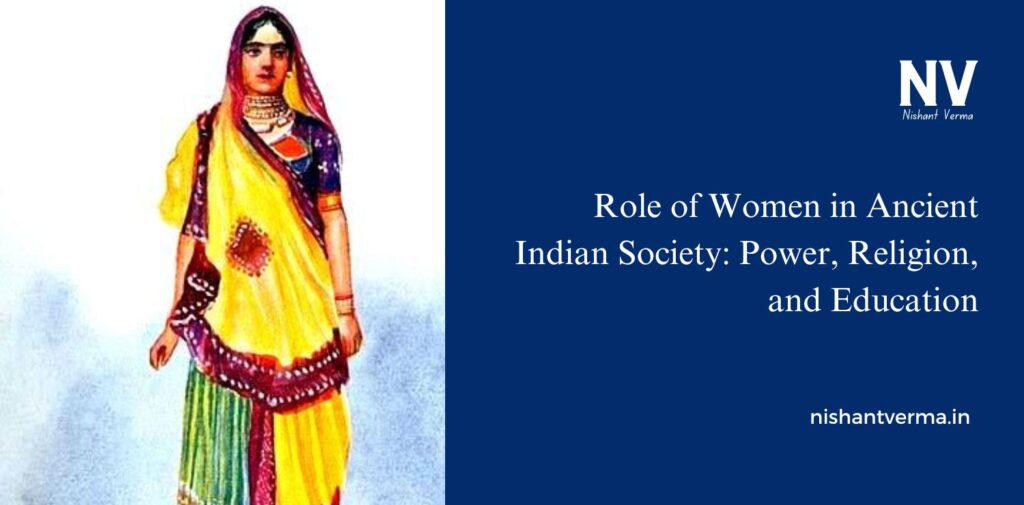India, with its rich history, has always been a land of great traditions, beliefs, and cultures. Women in Ancient Indian played an important role in society, even though their position and rights were often shaped by the customs and traditions of the time. From powerful queens to religious leaders and scholars, women in ancient India had a presence that impacted many aspects of life, including power, religion, and education. This article explores how women in ancient Indian society were involved in these areas, helping us understand their role in shaping the culture and history of India.
The Power of Women: Ruling and Leading
In ancient India, women were not just confined to their homes or kitchens; they held powerful positions and played key roles in the political landscape. Many queens and women from royal families had significant influence over the kingdom. They were not just the wives of kings but also leaders who contributed to the welfare and success of their kingdoms.
One of the most famous women rulers in ancient India was Rani Durgavati. She was a warrior queen who bravely fought against the Mughal Empire to protect her kingdom in the 16th century. She proved that women could be powerful leaders and warriors, just like men.
Another example is Queen Prabhavati Gupta, who ruled during the Gupta Empire in the 4th century. After the death of her husband, she took charge of the kingdom and successfully maintained the power of the Gupta dynasty. These examples show that, even though women were sometimes expected to stay in the background, there were several women who proved that they could rule and lead with strength and wisdom.

Women in Religion: Spiritual Leaders and Goddesses
Religion in ancient India was an important part of daily life, and women had an essential role in this area too. Hinduism, which is one of the oldest religions in the world, has always celebrated the strength of women, both as goddesses and as spiritual guides.
In Hinduism, many goddesses are worshipped, and they represent various aspects of life. Durga, for example, is known as the warrior goddess who protects the world from evil. She is a symbol of female strength and power. Lakshmi, the goddess of wealth and prosperity, is another example of how women are revered in Indian religion. These goddesses are not just figures of worship; they represent qualities like wisdom, power, and care that are essential for the well-being of society.
Women also held important roles as spiritual leaders in ancient India. Many women were respected for their knowledge of scriptures and philosophy. Maitreyee, a famous philosopher from ancient India, is known for her wisdom and her teachings on spiritual matters. Her thoughts on life and afterlife are still respected today.
Women and Education: Learning and Teaching
Education in ancient India was not just limited to men. Women, too, had opportunities to learn and teach, although their access to education was often more limited than that of men. Nevertheless, many women in ancient India made significant contributions to knowledge and education.
The Brahmavidyas, or women scholars, were well-respected in ancient India. These women were well-versed in sacred texts, philosophy, and even mathematics. One such famous figure was Gargi Vachaknavi, a great philosopher and scholar from the Vedic period. She was known for her deep knowledge of the Vedas, which are the oldest Hindu scriptures. Gargi is often remembered for her intellectual debates with male scholars, which showed that women were not only respected for their wisdom but also equal to men in matters of knowledge.
Vachaknavi, another wise woman from the Vedic period, is famous for her work as a teacher and philosopher. She passed on her knowledge to the younger generations, and her contributions helped shape the intellectual traditions of ancient India.
Even though education for women was often restricted to certain classes and regions, the examples of these women show that, in ancient India, education was not just a privilege for men, but a pursuit for women as well.

Women in Family Life: Nurturers and Caregivers
In ancient Indian society, the role of women in family life was very important. Women were often the center of the home and family, taking care of children, managing the household, and supporting their husbands. However, this did not mean that women were powerless or had no say in the matters of the house. In fact, women had a significant influence on the family structure.
Mothers in ancient India were highly respected. They were considered the first teachers of their children, passing on the values and knowledge of their culture. Women were responsible for teaching the young ones about religion, customs, and daily life.
Additionally, women were also involved in trade and agriculture, especially in rural areas. They contributed to the economic well-being of their families by engaging in activities like weaving, pottery, and farming. Even in the home, women managed the family’s finances and resources, demonstrating their ability to handle practical matters with wisdom and skill.
Challenges Faced by Women
While many women in ancient India had the opportunity to shine, their rights were still limited by the social and cultural norms of the time. The ancient society was mostly patriarchal, meaning that men held the primary positions of power and authority, while women were expected to stay in the home or follow the orders of their fathers, husbands, or sons.
In many cases, women’s education was limited to skills that were seen as necessary for managing the home. Women’s participation in public life, politics, and religious ceremonies was restricted in many parts of society. However, despite these challenges, many women still managed to rise above their circumstances and make their voices heard.

Conclusion: Women in Ancient Indian Society
The women of ancient India played an essential role in shaping the history and culture of the country. While they faced many challenges, they were able to leave their mark on power, religion, and education. From queens like Rani Durgavati to scholars like Gargi Vachaknavi, these women showed that they were strong, intelligent, and capable of making a difference in society.
Even though women in ancient India faced restrictions, their contributions to family life, religion, and education were significant. They may not have always been recognized as equals to men, but their wisdom, leadership, and strength helped shape the world we live in today.
By learning about these amazing women from India’s past, we can understand how their courage, intelligence, and determination paved the way for future generations. Their legacy reminds us that every person, regardless of their gender, has the power to influence the world and make it a better place.




